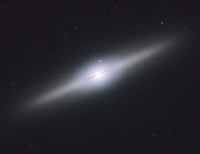Hubble finds relic of a shredded galaxy [heic1203]
15 February 2012
Astronomers using the NASA/ESA Hubble Space Telescope have found a cluster of young blue stars surrounding a mid-sized black hole called HLX-1. The discovery suggests that the black hole formed in the core of a now-disintegrated dwarf galaxy. The findings have important implications for understanding the evolution of supermassive black holes and galaxies.
 |
Sean Farrell of the Sydney Institute for Astronomy in Australia and the University of Leicester, UK, discovered a middleweight black hole in 2009 using the European Space Agency's XMM-Newton X-ray space telescope.
Black holes can be spotted using X-rays because of radiation coming from matter heating up as it swirls around and falls into the black hole. This phenomenon is known to astronomers as an accretion disc.
Known as HLX-1 (Hyper-Luminous X-ray source 1), this black hole weighs in around 20 000 times the mass of the Sun and lies towards the edge of galaxy ESO 243-49, which is 290 million light-years from Earth.
Now, Farrell's team has studied HLX-1 in ultraviolet, visible and infrared light using Hubble, and simultaneously in X-rays using the NASA/STFC/ASI Swift satellite.
"For a unique source we needed a unique telescope," explains Mathieu Servillat, second author of the study. "Hubble provided such precision in its images that it helped us understand the origin and environment of this intermediate-mass black hole."
Because HLX-1 is around 290 million light-years away, it is too far for Hubble to measure the individual stars around the black hole. However, a great deal can be deduced from the light that comes from it. Hubble's images of the region show an excess of red light, which cannot be explained by emissions from the accretion disc alone. This light, the team concludes, is evidence of a cluster of hot stars surrounding the black hole as the brightness and colour of the light is similar to that from star clusters in nearby galaxies.
"What we can definitely say with our Hubble data," says Farrell, "is that we require both emission from an accretion disc and emission from a stellar population to explain the colours we see."
The existence of a star cluster around the black hole in turn gives clues about where the intermediate mass black hole may have come from, and why it lies in its present location in ESO 243-49.
"The fact that there's a very young cluster of stars indicates that the intermediate-mass black hole may have originated as the central black hole in a very low-mass dwarf galaxy," Farrell explains. "The dwarf galaxy was then swallowed by the more massive galaxy."
As the dwarf galaxy was ripped apart, the black hole with some of its surrounding material would have survived.
The future of the black hole is uncertain at this stage. It depends on its trajectory, which is currently unknown. It's possible that the black hole may spiral into the centre of ESO 243-49 and merge with the supermassive black hole there. Alternatively, the black hole could settle into a stable orbit around the galaxy. Either way, it's likely to fade away in X-rays as it depletes its supply of gas.
The team has more observations planned this year to track the history of the interaction between the two galaxies.
The new findings are being published on 15 February in the Astrophysical Journal.
Notes
The Hubble Space Telescope is a project of international cooperation between ESA and NASA.
The international team of astronomers in this study consists of S. A. Farrell (Sydney Institute of Astronomy, Australia, and University of Leicester, UK), M. Servillat (Harvard-Smithsonian Center for Astronomy, USA), J. Pforr (University of Portsmouth, UK), T.J. Maccarone (University of Southampton, UK), C. Knigge (University of Southampton, UK), O. Godet (Universty of Toulouse, France, and CNRS IRAP, France), C. Maraston (University of Portsmouth, UK), N.A. Webb (University of Toulouse, France, and CNRS IRAP, France), D. Barret (University of Toulouse, France, and CNRS IRAP, France), A. Gosling (University of Oxford, UK), R. Belmont (University of Toulouse, France, and CNRS IRAP, France), K. Wiersema (University of Leicester, UK).
These results are reported in a paper entitled "A young stellar population around the intermediate mass black hole ESO 243-49 HLX-1", published in the Astrophysical Journal on 15 February.
Contacts
Sean Farrell
University of Sydney
Sydney, Australia
Tel: +61-2-9351-7688
Email: sean.farrell sydney.edu.au
sydney.edu.au
Mathieu Servillat
Harvard-Smithsonian CfA, Cambridge, USA
(now CEA Saclay, Paris, France)
Tel: +33-1-69-08-95-76
Email: mservillat cfa.harvard.edu
cfa.harvard.edu
Oli Usher
Hubble/ESA
Garching, Germany
Tel: +49-89-3200-6855
Email: ousher eso.org
eso.org

